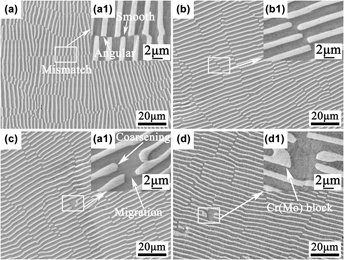Article contents
Microstructure evolution of NiAl–Cr(Mo) planar eutectic lamellar structure during high temperature treatment
Published online by Cambridge University Press: 05 July 2018
Abstract

The microstructure evolution of the directionally solidified NiAl–Cr(Mo) planar eutectic lamellar structure was studied at 1150 °C and times of up to 400 h. The planar eutectic lamellar structure is obtained at the withdrawal rate range of 2.5–7.5 μm/s. The interlamellar spacing decreases gradually with increasing the withdrawal rate. The lamellar termination (like angular or smooth) commonly exists in the as-DS alloy. After high temperature treatment, the lamellar structure at 2.5 μm/s (interlamellar spacing, 3.7 μm) is almost stable, only a little migration of termination occurs at 400 h. When the withdrawal rate increases to 4.5 μm/s, the coarsening and migration of termination occur at 200 h. The adjacently coarsened terminations assemble when the coarsening processes to a certain degree, thus resulting in the formation of the blocky Cr(Mo) phase. Similarly, the above instable phenomenon occurs at 7.5 μm/s. The relevant instability mechanisms are discussed.
- Type
- Article
- Information
- Copyright
- Copyright © Materials Research Society 2018
References
REFERENCES
- 8
- Cited by


